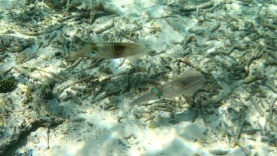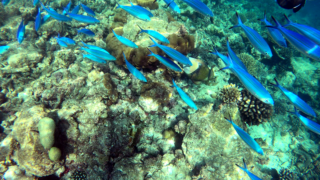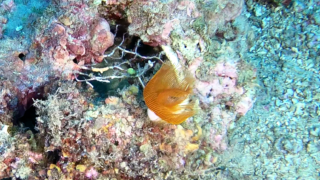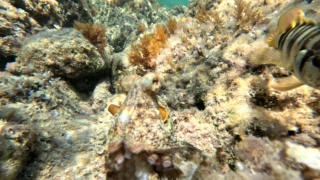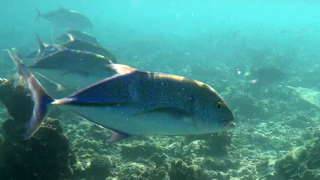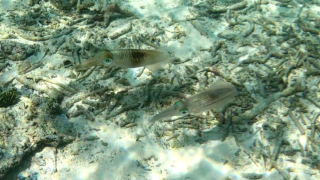School of grey Mullet grazing
Flathead grey mullets it is a fish able to withstand wide variations in salinity, in fact we find it regularly in marine waters, fresh or brackish waters. Extremely adaptable to all environments; we often find it at the mouths of rivers, in lagoon areas where sea water mixes with fresh water from the hinterland and inside bays and harbors. Usually shy and suspicious, because often the object of predatory fish hunting, in this case he let himself be approached by the diver’s camera who took the opportunity to make a close encounter. branco di muggini al pascolo

The flathead grey mullet, Mugil cephalus, is an important food fish species in the mullet family Mugilidae. It is found in coastal tropical and subtropical waters worldwide. Its length is typically 30 to 75 centimetres. It is known with numerous English names, including the flathead mullet, striped mullet (US, American Fisheries Society name), black mullet, bully mullet, common mullet, grey mullet, sea mullet and mullet, among others. The flathead grey mullet is a mainly diurnal coastal species that often enters estuariers and rivers. It usually schools over sand or mud bottoms, feeding on zooplankton. The adult fish normally feed on algae in fresh water. The species is euryhaline, meaning that the fish can acclimate to different levels of salinity The back of the fish is olive-green, sides are silvery and shade to white towards the belly. The fish may have six to seven distinctive lateral horizontal stripes. Lips are thin.

The mullet has no lateral line. A common length is about 50 centimetres, and its maximum length is 100 centimetres. It can reach a maximum weight of eight kilograms The roe of this mullet is salted, dried, and compressed to make a specialty food across the world, such as Greek avgotaraho, Taiwanese wuyutsu, Korean eoran, Japanese karasumi, Italian bottarga, Turkish Haviar and Egyptian batarekh. In Egypt, the fish itself is salted, dried, and pickled to make fesikh. On the coast of Northwest Florida and Alabama, this mullet, called the striped or black mullet, is often a specialty of seafood restaurants. Fried mullet is most popular, but smoked, baked, and canned mullet are also eaten. Local fishermen usually catch mullet in a castnet, though most use a land based seine net. Mullet is a delicacy in this area and is most often consumed in the home. Mullet are usually filleted, and the remaining frames used for fish stock, used in chowders and stews. The mullet most commonly consumed in Florida however is the white mullet (Mugil curema), because its preference for cleaner water gives it a cleaner and less muddy taste.









